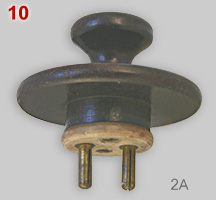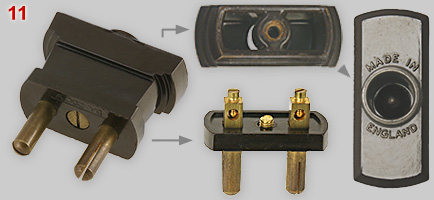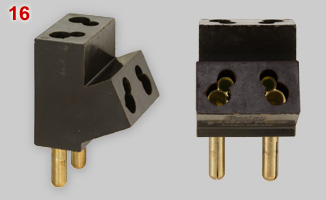 |
BS 372 : 1930 Part I not earthed plugs and sockets |
| BS 372:1930 Part I was the last BS 372
standard
for not earthed, 2-pin plugs and sockets. Images below show examples
that date back to the 1930s - '60s. The use of not earthed
sockets and plugs ended in 1970 when BS 373 Part I was withdrawn,
following the introduction of BS 4573. |
BS
4573:1970 defines 2-pin shaver plugs and
sockets. They are the only not earthed domestic devices allowed nowadays in the UK. A concise history of British plugs and sockets is given on a separate page |
 |
 |
 |
 |
| 2A, 5A, 10A and 15A plugs in images 1 - 4
are depicted with an uniform degree of reduction. Specification of pin diameter, length and spacing are given in a table below. |
|
| 1 | BS 372 Part
I 2-pin 2A plug.
Manufacturer: Ward & Goldstone. Dating: 1950s - '60s. {MSt} |
| 2 | BS
372 Part I socket and plug, both rated at 5A - 250V. Shown on socket: U.K. Patent No. 473440 for "Improvement in and relating to sockets and socket mountings for electrical plug connections" was granted to Ward & Goldstone in 1937. {DP} The flat top plug complies with BS 372, that refers to "Two-pin Side-entry Wall Plugs and Sockets for Domestic Purposes". Manufacturer: General Electric Company (GEC); they have made such plugs from early 1930 to (at least 1950s. {JM} |
| 3 | BS
372 Part I 10A plug made by Clix*. A rating of 10 A
is an uncommon 'relict' of the old Union gauge (see historic
note below). It did not comply to BS 73 and
following BS 372. These standards described 2A, 5A, 15A and 30A only.
Plug dating: possibly 1950s. * Clix plugs had an unique type of wire attachment; image no. 14 shows the principle in detail. |
| 4 | CLIX
BS
372 Part I plug, rated at 15A - 250V. The plug has a cord side entry,
comparable to
plug no. 5. Image nos 1 to 4 are shown in proportion to each
other. {GP} |
 |
 |
 |
 |
 |
 |
 |
| 5 |
BS 372 Part 1 socket rated at 15A - 250V, made in England. UK Pat. APPD. 14137/56 is indicated, but no company name. |
| 6 | British Standard 2-pin adapter making a 15A socket accessible for a B.S. 5A plug. Manufacturer: MK. Dating: 1930s. {BNS} |
| 7 | Wooden 10A - 250V plug. 10A not earthed plug. Early 20th century known as Union Gauge plugs. {BNS} |
| 8 | Porcelain
BS 317 2A -50V socket and plug. Socket was intended for
installation in n appliance. Dating: late 1920s. Socket manufacturer:
Crabtree. {BNS} |
| 9 |
Wooden 2A plug with top cord entry. Dating: probably 1920s.No name or indication of manufacturer. {BNS} |
| 10 |
2A plug with strikingly large Bakelite safety cap and grip. Unknown manufacturer. {BNS} |
| 11 | Bakelite
BS 372 Part 1 2A - 250V plug with cord side entry. Dating: late 1930s -
early 1950s. Manufacturer: Crabtree. {BNS} |
 |
 |
 |
|
| 12 |
5A CLIX type 5/2/B plug. Flex cord is gripped by a grub screw (made of wood), an improvement that has been patented by Charles Reginald Cook (Chesworth, Horsham, Sussex). Patent no. GB426943, granted on December 28, 1933. The patented CLIX wire fixation system is show in detail in image no. 13. {MS} |
| 13 |
Plug shows text: 5A.250V. B.S.GAUGE and has been made by General Electric Company. Pin spacing (16.7 mm) and diameter of pins (5.1 mm) are in accordance with BS 372 Part I, but pins are shorter: 13.3-13.5 mm, rather than 15.9 mm. This type of 5A plug was generally used for flex cords. Dating: 1960s. {ASw} |
| 14 |
CLIX type 5A plug, which allows the attachments of
wires without using any tools. The principle of wiring a CLIX plug: [1] unscrew cap; [2] release pins by pressing them inwards; [3] put wire through the loop of a pin; [4] insert pin with wire into the base of the plug and press the pin fully down; [5] screw the cap tightly down (this is essential to keep the wires in a safely locked position !). The wire fixation system has been patented by four patents (GB371404, GB371418, GB403448, GB457113), granted between April 18, 1932 and October 4, 1935 to C.R. Cook. {RM} Note that the flex cable entry is opposite the plug face. Although top entry plugs were very common in the UK, they do not fully comply with BS 372 Part I or the preceding BS 73. British Standard require that the cord enters at the side (note given by David Peacock). |
 |
 |
 |
 |
| 15, 16 |
5A BS 372 Part I plug, made by an unknown
company that
used a logo with tumble switch and letter B. Pin diameter = 5.1 mm;
length = 13.5 mm (incl. rubber sleeve),
spacing = 16.5 mm. Image no. 9 shows three
remarkable features. (1) pins have short rubberized sleeves at the holes of Bakelite housing. Sleeves seal pin-contact connection. (2) the two parts of Bakelite housing are identical to each other and can be used for both plug (no. 16, left) and connector (no 16, middle), because they have two pairs of cut-outs for screws to fix wires of pins (lower cut-out pair) and contacts (upper cut-out pair). A simple production cost effective solution. (3) although pin diameter and spacing is conform 5A not earthed BS 372, holes in the Bakelite cast provide the possibility to add an external earth wire (to be connected separately to an appliance). Image of connector plug (no. 16, right) has been provided by Ian Green. {IG} |
| 17 |
5A
BS 372 Part I plug. Separate entries for line and neutral wires rather
than a single, larger hole might have been chosen because of the plug
thickness of only 11 mm. The patterned plug surface gives a remarkably
good grip. Pin diameter = 5.1 mm; length = 14.3 mm; spacing = 16.6 mm. As plug no. 15 the two halves of Bakelite plug housing can be used for both plug and connector. However top and bottom halves are not fully identical. Top half has holes for screws, while the bottom half has corresponding threat. Inside, the name Lektrik is visible, a registered trademark used by A.P. Lundberg and Sons of London for electrical accessories. {IG} |
| 18 |
5A BS 372 Part I plug, made in England by
an unknown company. The 38 mm wide top half provides an excellent grip. Pin diameter = 5.1 mm; length = 15.3; spacing = 16.6 mm. {IG} |
 |
 |
| 19 |
5A BS 372 Part I plug. Product no. 631 has a logo with letters WT and carries the name EMPIRE. It is not clear whether Empire is a company name or a geographical indication (see for example no. 26). Grace's Guide gives a list of companies named 'Empire'; from motor cycles to umbrella frames. None of them could be linked to a manufacturer of electrical accessories. {IG} |
| 20 |
Bakelite 2-pin multi-plug. Classic design made by Ward & Goldstone, who used the trademark Goltone. An inscription on top warns that the maximum load may not exceed 5A, 250V. {ASw} |
 |
 |
 |
 |
 |
|

|
| 21 |
Surface mount 5A BS 372 Part 1 socket with switch. Manufacturer: MK Electric. Dating: late 1960s. {DH} |
| 22 |
White plastic 3-way 5A, 2-pin multi-plug. Brand name: Clang. {ASw} |
| 23 |
BS 372 Part I 5A multi-plug with outlets for 5A and 2A BS 372 Part I plugs. Made in England by Grelco. {DP} |
| 24 | BS 372 Part 1 10A, not earthed multi-plug made of a wood-like polymer. No indication of manufacturer. {BNS} |
| 25 | Bakelite BS 546 15A multi-plug with two BS 372 Paer 1 5A outlets and a single BS 546 15A outlet. Dating: late 1930s - '50. Made in England by CLANG. {BNS} |
| 26 |
13A BS 1363 multi-plug, 'Empire Made' by Livia Electrical (model 5067). Besides a single BS 1363 outlet (with compulsory shutters) it also has two outlets for 5A 2-pin plugs. In the 1950s to '70s it was quite common to have 2-pin plugs on small appliances. The 2-pin outlets were convenient when people moved or had their house upgrades to BS 1363, but didn't like to change each unearthed round pin plug. {DF} |
 |
 |
| 27 |
Polarized 2-pin connector plug, MADE
IN
ENGLAND. Rating: 10A - 250V. General Electric Company shows in
the 1934 catalog - section 'Polarity Patterns' - a similar socket and
plug (image right). It seems that there was a manufacturer logo below
the horizontal slot, but it is not clear whether it was the GEC logo.
The connector does not comply with BS 372. Neither US T-slot (NEMA 2-20) nor Australian Extra Low Voltage plugs fit in the British connector, because of differences in flat pin size and spacing. |
| Characteristics of BS 372: 1930 Part I plugs* |
| current rating |
pin diameter |
pin
length |
pin
spacing (centre to centre) |
|
| 2A |
3.6 mm |
12.7 mm |
12.0 mm |
see image 1 |
| 5A | 5.1 mm |
15.9 mm |
16.7 mm |
image 2 and 5-12 |
| 10A |
5.0 mm | 19.6 mm | 19.5 mm | image 3 |
| 15A |
7.0 mm | 20.6 mm | 22.3 mm | image 4 |
| 30A |
7.9 mm |
28.6 mm |
32.0 mm |
not in collection |
| * including 10A not earthed plugs, the old
Union Gauge; no longer defined by BS 372 Part I. Specifications of line and neutral pins of BS 372 Part I plugs differ from 3-pin BS 372 Part II plugs. Consequently, not earthed plugs don't fit in earthed sockets that have the same current rating. |
| The South Africa classic page shows an example of an old, wooden 2-pin plug and socket. |
|
|
|
|
|
|